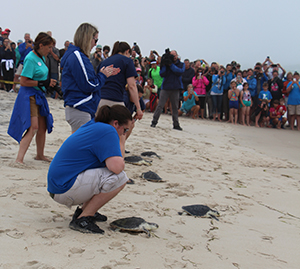Sea Turtles Serve as Conservation Ambassadors
By Amy Nelson
Before being released, each rehabilitated turtle is tagged with a microchip placed just under the skin of its left shoulder. Turtles above a certain size are also tagged with a numbered, metal flipper tag. These ID tags are entered into a large, national database, so if a tagged turtle is found stranded, or caught in a fishing net, rescuers can be much more informed about that animal before they administer care.

If they come across a turtle that has been repeatedly cold stunned, for example, rescuers may decide not to reintroduce the turtle, but send it to a facility where it can be treated and then exhibited for conservation outreach and education purposes. In some cases, often when funded by a donor, satellite tags are affixed to the rehabilitated turtle’s shell, so its migration can be tracked.
Of the 15 cold-stunned turtles sent from the New England Aquarium, all but one recovered so well that they were transported to Florida in April for early release. The remaining turtle, a green turtle dubbed Beachcomber, needed a bit more time and antibiotics to recover from a rare blood infection and kidney problems. Joining Beachcomber in the therapy pool is another cold-stun victim named Hardshell. Also a green turtle, Hardshell who was rescued off the coast of Delaware with a damaged shell. Though White and the animal rescue team cannot be certain, they surmise the damage was caused by a boat strike.
For an animal rescuer, the joys of treating and ultimately releasing rescued animals help balance the horror of such injuries.

“Seeing these turtles at their worst and then releasing them at their best feels like you are completing a circle, like you are really contributing,” said White, “especially with the Kemp’s ridleys, which are endangered. You are helping put an endangered animal back into the water so it can hopefully make more little Kemp’s ridleys.”
White puts good odds on the rehabilitated turtles’ survival. “These turtles are pretty feisty,” she said. “I’m fairly confident that they can hold their own.”
 Just six days ago, Beachcomber and Hardshell joined ten Kemp’s ridley sea turtles rescued by the Pittsburgh Zoo & PPG Aquarium and National Marine Life Center in Massachusetts for a public release on Maryland’s Asseateague Island. The grey, drizzly weather neither deterred nor disheartened an excited crowd of more than 200 people who came to watch the release.
Just six days ago, Beachcomber and Hardshell joined ten Kemp’s ridley sea turtles rescued by the Pittsburgh Zoo & PPG Aquarium and National Marine Life Center in Massachusetts for a public release on Maryland’s Asseateague Island. The grey, drizzly weather neither deterred nor disheartened an excited crowd of more than 200 people who came to watch the release.

The release kicked off as staff from all three aquariums unloaded special carriers containing the soon-to-be-released turtles. The crowd, which ranged from toddlers to seniors, began to stir with anticipation and curiosity.

Before the turtles were released, staff from all three facilities give spectators a chance to see the animals up close. To the untrained observer, the turtles, too, seemed eager for the release.
The Kemp’s ridleys were released first. The turtles were gently placed in the sand, about 30 feet from the shore. A hush came over the crowd as they watched the turtles slowly take their first few steps toward the ocean. Gradually, each turtle’s pace quickened–exponentially so upon the animal’s first touch of a breaking wave. From there, they quickly, smoothly disappeared into the surf.
Beachcomber and Hardshell were the last two rescued turtles to be released. By that time, the drizzle had become a steady rain. A National Aquarium staffer carefully placed Beachcomber on the sand. Despite the rain, and despite the fact that she, Amber, and the rest of the rescue team would very likely never see Beachcomber again, she smiled brightly.
Within minutes, Beachcomber entered the Atlantic Ocean. (Footage courtesy of The National Aquarium)
Beachcomber’s release came just in time, as Amber and her colleagues must ready the animal rescue facility for its next round of patients, those who will come during sea turtle rescue’s second season: summer. Increased boat traffic and fishing mean boat strikes, propeller slashes, fish hook ingestion, and entanglement in fishing gear.

But White remains optimistic. The people she meets when she does outreach in coastal communities, or when she responds to a call from a boater who has spotted a stranded turtle, give her hope. It is likely that those people would say the same about Amber White and others who are part of the National Aquarium’s animal rescue program, which celebrates its 25th anniversary this year. Thanks to their conservation efforts, there are likely a whole lot of healed marine animals out there…including little Kemp’s ridleys.
The mission of the National Aquarium in Baltimore is to inspire the conservation of the world’s aquatic treasures. As hard as the Aquarium’s staff members and volunteers work to further that mission, perhaps the institution’s most powerful conservation ambassadors are the marine animals themselves. We visited the National Aquarium recently, and had the chance to see three sea turtles who are raising curiosity, touching hearts, and giving us greater hope and motivation when it comes to conservation.
The expansive exhibit offers visitors overhead and underwater views of Calypso and the other animals in the habitat. A swim-by from this massive animal elicits audible gasps, and crowds gather just to see her eat lettuce from a custom-designed coral reef rock-mimicking feeder. Inevitably, according to Bourbon, this fascination leads to questions—about Calypso and about sea turtles in general.
“Calypso is a great conservation ambassador,” says Bourbon, “because she is a really good story.”
Calypso’s story helps inform people of sea turtles’ vast migratory journeys and the human-induced threats they face along the way. As a reptile in a reef exhibit, Calypso also helps illustrate the diversity of life in a thriving coral reef system. Perhaps one of the most powerful themes of Calypso’s story is one of resilience and survival, a message that resonates well with the National Aquarium’s many disabled visitors, according to Bourbon.
In the coastal beach section of this exhibit is a temporary visitor to the Aquarium, a juvenile loggerhead sea turtle. Referred to as Sheldon, a name bestowed upon the yet unsexed turtle in a public naming contest, the loggerhead was sent to the National Aquarium as part of a program run by the North Carolina Aquarium at Pine Knoll Shores. The program rescues imperiled hatchlings and then loans them to participating public aquariums for rehabilitation. As with Sheldon, the hatchlings are integrated into appropriate exhibits as they are rehabilitated, so they can be seen—although not interacted with–by the public. Judging by the excited reactions a mere loggerhead swim-by elicits from the school children swarming the Maryland: Mountains to the Sea exhibit, Sheldon is a crowd favorite.
According to Jay Bradley, the National Aquarium’s curator of fishes and gallery exhibits, it is very likely that Sheldon would not be alive were it not for the North Carolina Aquarium’s rescue and rehabilitation program.
For tiny sea turtle hatchlings, the open sand journey from nest to sea is like running the gauntlet. If they are lucky enough to evade hungry gulls, foxes, raccoons, and crabs and make it into the water, they must then escape even more predators like carnivorous fish and sea birds ready to swoop them from the surface. And then there are the hazards introduced by humans. Loggerheads usually hatch on a full moon, so light pollution from coastal development can disorient the hatchling. Trash may not only impede a hatchling’s journey to the water, but be mistaken for jellyfish in the water and ingested. Add to these threats the risk of boat strikes and entanglement in ghost fishing gear, it’s no wonder sea turtles are said to have a 1% chance of surviving to maturity.
Though Sheldon’s particular imperilment as a hatchling is unknown, he/she is growing nicely. “It always amazes me how small these animals are when they hatch,” says Bradley, who has participated with the loggerhead program for many years. “It is really neat to see them grow and progress so much.”
A short walk from the Maryland: Mountains to the Sea exhibit gallery, is a seating area with a large, floor-to-ceiling window that offers visitors an expansive view of Baltimore’s Inner Harbor. It doesn’t take long to spot a few plastic bags and bottles floating in the water. Sheldon has some heavy lifting to do.
“We once had a cold-stunned turtle whose core body temperature was 36 degrees,” said Amber. “We initially had to keep him on ice in a highly air conditioned room in the middle of winter in order to ensure he’d warm gradually.”
In 2014, when Massachusetts experienced a record-breaking cold-stunning event, the New England Aquarium was overwhelmed with hundreds of cold-stunned turtles–mostly the endangered Kemp’s ridley. The National Aquarium took 35 of the turtles, twice as many as they typically rehabilitate during cold-stun season. “I think they even shipped some to Texas,” said White. “They jokingly called it the Kempocalypse.”
If they come across a turtle that has been repeatedly cold stunned, for example, rescuers may decide not to reintroduce the turtle, but send it to a facility where it can be treated and then exhibited for conservation outreach and education purposes. In some cases, often when funded by a donor, satellite tags are affixed to the rehabilitated turtle’s shell, so its migration can be tracked.
Of the 15 cold-stunned turtles sent from the New England Aquarium, all but one recovered so well that they were transported to Florida in April for early release. The remaining turtle, a green turtle dubbed Beachcomber, needed a bit more time and antibiotics to recover from a rare blood infection and kidney problems. Joining Beachcomber in the therapy pool is another cold-stun victim named Hardshell. Also a green turtle, Hardshell who was rescued off the coast of Delaware with a damaged shell. Though White and the animal rescue team cannot be certain, they surmise the damage was caused by a boat strike.
For an animal rescuer, the joys of treating and ultimately releasing rescued animals help balance the horror of such injuries.
The Kemp’s ridleys were released first. The turtles were gently placed in the sand, about 30 feet from the shore. A hush came over the crowd as they watched the turtles slowly take their first few steps toward the ocean. Gradually, each turtle’s pace quickened–exponentially so upon the animal’s first touch of a breaking wave. From there, they quickly, smoothly disappeared into the surf.
Beachcomber and Hardshell were the last two rescued turtles to be released. By that time, the drizzle had become a steady rain. A National Aquarium staffer carefully placed Beachcomber on the sand. Despite the rain, and despite the fact that she, Amber, and the rest of the rescue team would very likely never see Beachcomber again, she smiled brightly.
Within minutes, Beachcomber entered the Atlantic Ocean. (Footage courtesy of The National Aquarium)
Beachcomber’s release came just in time, as Amber and her colleagues must ready the animal rescue facility for its next round of patients, those who will come during sea turtle rescue’s second season: summer. Increased boat traffic and fishing mean boat strikes, propeller slashes, fish hook ingestion, and entanglement in fishing gear.
